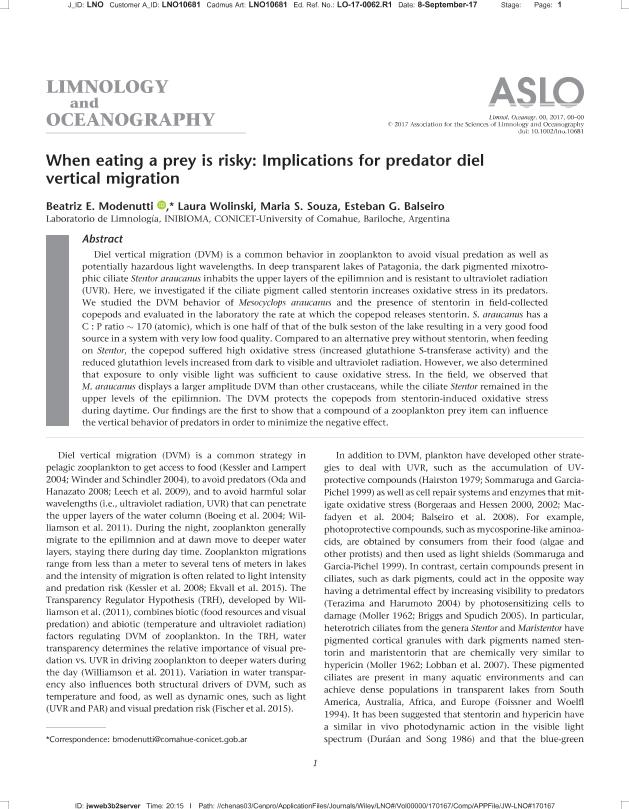Mostrar el registro sencillo del ítem
dc.contributor.author
Modenutti, Beatriz Estela

dc.contributor.author
Wolinski, Laura Isabel

dc.contributor.author
Souza, María Sol

dc.contributor.author
Balseiro, Esteban Gabriel

dc.date.available
2018-01-09T19:56:39Z
dc.date.issued
2017-09
dc.identifier.citation
Balseiro, Esteban Gabriel; Souza, María Sol; Wolinski, Laura Isabel; Modenutti, Beatriz Estela; When eating a prey is risky: Implications for predator diel vertical migration; Amer Soc Limnology Oceanography; Limnology and Oceanography; 9-2017; 1-12
dc.identifier.issn
0024-3590
dc.identifier.uri
http://hdl.handle.net/11336/32724
dc.description.abstract
Diel vertical migration (DVM) is a common behavior in zooplankton to avoid visual predation as well as potentially hazardous light wavelengths. In deep transparent lakes of Patagonia, the dark pigmented mixotrophic ciliate Stentor araucanus inhabits the upper layers of the epilimnion and is resistant to ultraviolet radiation (UVR). Here, we investigated if the ciliate pigment called stentorin increases oxidative stress in its predators. We studied the DVM behavior of Mesocyclops araucanus and the presence of stentorin in field-collected copepods and evaluated in the laboratory the rate at which the copepod releases stentorin. S. araucanus has a C : P ratio ∼ 170 (atomic), which is one half of that of the bulk seston of the lake resulting in a very good food source in a system with very low food quality. Compared to an alternative prey without stentorin, when feeding on Stentor, the copepod suffered high oxidative stress (increased glutathione S-transferase activity) and the reduced glutathion levels increased from dark to visible and ultraviolet radiation. However, we also determined that exposure to only visible light was sufficient to cause oxidative stress. In the field, we observed that M. araucanus displays a larger amplitude DVM than other crustaceans, while the ciliate Stentor remained in the upper levels of the epilimnion. The DVM protects the copepods from stentorin-induced oxidative stress during daytime. Our findings are the first to show that a compound of a zooplankton prey item can influence the vertical behavior of predators in order to minimize the negative effect.
dc.format
application/pdf
dc.language.iso
eng
dc.publisher
Amer Soc Limnology Oceanography

dc.rights
info:eu-repo/semantics/openAccess
dc.rights.uri
https://creativecommons.org/licenses/by-nc-sa/2.5/ar/
dc.subject
Antioxidants
dc.subject
Uvr
dc.subject
Ciliates
dc.subject
Predation
dc.subject.classification
Otras Ciencias Biológicas

dc.subject.classification
Ciencias Biológicas

dc.subject.classification
CIENCIAS NATURALES Y EXACTAS

dc.title
When eating a prey is risky: Implications for predator diel vertical migration
dc.type
info:eu-repo/semantics/article
dc.type
info:ar-repo/semantics/artículo
dc.type
info:eu-repo/semantics/publishedVersion
dc.date.updated
2017-12-15T14:33:29Z
dc.journal.pagination
1-12
dc.journal.pais
Estados Unidos

dc.description.fil
Fil: Modenutti, Beatriz Estela. Consejo Nacional de Investigaciones Científicas y Técnicas. Centro Científico Tecnológico Conicet - Patagonia Norte. Instituto de Investigaciones en Biodiversidad y Medioambiente. Universidad Nacional del Comahue. Centro Regional Universidad Bariloche. Instituto de Investigaciones en Biodiversidad y Medioambiente; Argentina
dc.description.fil
Fil: Wolinski, Laura Isabel. Consejo Nacional de Investigaciones Científicas y Técnicas. Centro Científico Tecnológico Conicet - Patagonia Norte. Instituto de Investigaciones en Biodiversidad y Medioambiente. Universidad Nacional del Comahue. Centro Regional Universidad Bariloche. Instituto de Investigaciones en Biodiversidad y Medioambiente; Argentina
dc.description.fil
Fil: Souza, María Sol. Consejo Nacional de Investigaciones Científicas y Técnicas. Centro Científico Tecnológico Conicet - Patagonia Norte. Instituto de Investigaciones en Biodiversidad y Medioambiente. Universidad Nacional del Comahue. Centro Regional Universidad Bariloche. Instituto de Investigaciones en Biodiversidad y Medioambiente; Argentina
dc.description.fil
Fil: Balseiro, Esteban Gabriel. Consejo Nacional de Investigaciones Científicas y Técnicas. Centro Científico Tecnológico Conicet - Patagonia Norte. Instituto de Investigaciones en Biodiversidad y Medioambiente. Universidad Nacional del Comahue. Centro Regional Universidad Bariloche. Instituto de Investigaciones en Biodiversidad y Medioambiente; Argentina
dc.journal.title
Limnology and Oceanography

dc.relation.alternativeid
info:eu-repo/semantics/altIdentifier/url/http://doi.wiley.com/10.1002/lno.10681
dc.relation.alternativeid
info:eu-repo/semantics/altIdentifier/url/http://onlinelibrary.wiley.com/doi/10.1002/lno.10681/abstract
Archivos asociados
